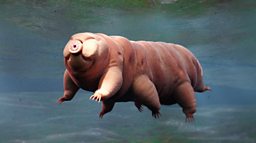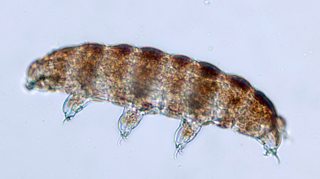Seven Things We Learned About Invincible Tardigrades

“Water Bears”, “Moss Piglets”, indestructible “aliens” – the 1500 species of tardigrades are weird and wonderful micro-animals that have been with us for 530 million years and yet we are still getting to know them and their capabilities.
For Curious Cases, Dara Ó Briain and Hannah Fry put tardigrades under the microscope to find out if the have superpowers of survival. Can they really survive, drought, extreme cold and radiation? Are they a triple threat and able to outlive us all when the apocalypse comes?
Here are seven things we learned about tardigrades:
They are micro-animals
Dating back to the Cambian era, 530 million years ago, tardigrades are aquatic eight-legged micro-animals of less than a millimetre in length, typically 500 microns. They have most of the organs seen in larger animals: mouth, gut, anus, brain, nervous system etc. – all adding up to around 1000 cells.
“They all have something called a ‘stylus’ that comes out of the mouth region which they use to penetrate cells of other animals and plants,” explains cell biologist Dr Nadja Møbjerg: University of Copenhagen. “They also have a large suction pharynx, which they use to suck out whatever fluids they can get out of the cells that they penetrated.”

锘縏hey look like water bears, moss piglets or even aliens
In appearance some tardigrades look like bears and are known as “Water Bears”, as all tardigrades need a film of water of some kind to survive (ponds, sea, wet grasses etc.). Dr James Frederick Fleming from Natural History Museum of Norway [and the University of Oslo] explains that the bear comparison also comes from tardigrades having a “distinctive kind of lumbering gait that you see whenever you see them under the microscope.”
Other tardigrades, within the 1500 known species, look more like piglets, and because some live in wet mosses in ponds or on the roofs of houses they get the name “Moss Piglets.” “One of the most studied tardigrades on the planet was first found in a rain gutter in England,” notes Dr Fleming.
“There are also species that are more alien-like with long sensory organs coming out of the head and different places on their body,” adds Dr Møbjerg.
They can survive drought
Despite their need for water, tardigrades can survive droughts by entering what is known as a “tun state” where they tuck in their cells and organ systems, stopping their metabolism and decreasing their volume by 80-90%. When the water returns, the tardigrades are able to revive and come back to life. As with all life forms, tardigrades started out in the ocean and, as Dr Fleming explains, the tun state “is the way they have adapted to life on land.”

There are anecdotal reports that tardigrades have been able to resuscitate after 120-year-old mosses were rehydrated in the 1980s and some movement was observed, but empirical evidence suggests that 30 years is the longest period between the tun state and revival.
Their “tun state” is a feat of engineering
The process of getting into a tun state involves 33 unique heat soluble genes to protect the tardigrade cells against dehydration, proteins that work as scaffolding and gels to protect the cells from the inside. In addition, the tardigrade’s muscles work to induce a rigor mortis state that keeps their structure during their metabolic shutdown.
They are highly resistant to radiation
In 2021, molecular biologist Thomas Boothby from the University took frozen tardigrades to space, thawed them out and cultured them on the International Space Station to study the effects of solar radiation on them. This was done with a view to prolong the time humans can spend in space.
Boothby and his team anticipated that the tardigrades would respond well, and they did. “They upregulated genes involved in repairing broken DNA and ameliorate the effects of radiation before they really have time to do a lot of damage.”
James illustrates just how well tardigrades are able to heal in radiation – humans can withstand 5 Grays (Gys – the unit of radiation per unit weight) of radiation, tardigrades can withstand 5000 Grays.
Withstanding an actual nuclear apocalypse is an ask for a tardigrade. While tardigrades would be ok with the fallout, Dr Møbjerg points out that they would be vulnerable to explosions and high temperatures.
锘縏hey nearly landed on the moon
Experiments on tardigrades have also involved exposing them to the vacuum of space for 10 days – around 50-60% returned. In another mission, a space probe carrying tardigrades crashed on the surface of the moon. The likelihood that we now have tardigrades on the moon was dashed by research at Queen Mary’s University in London who shot tardigrades in their tun state out of a gun at a speed of nearly 900mph, similar to the crash velocity. Sadly, all the tardigrades perished.
They are odds-on to survive the next mass extinction
Tardigrades have certainly weathered some storms since appearing on the planet over 500 million years ago. “There have been at least five really major mass extinctions since then,” notes Dr Fleming, “not just the asteroid that destroyed all the dinosaurs, but also grand eruptions of undersea vents that choked almost all of the life out of the ocean. There have been huge turnovers in what life on Earth looks like. And for some reason, Tardigrades seem to have done quite well with that. They can probably survive a sixth.”

More science from Radio 4
-
![]()
Can bubbles save the planet?
Hannah Fry and Dara 脫 Briain discover, the link between bubbles and environmental action isn鈥檛 as airy a notion as it might at first seem.
-
![]()
The Life Scientific
Professor Jim Al-Khalili talks to leading scientists about their life and work
-
![]()
The Infinite Monkey Cage
Brian Cox and Robin Ince host a witty, irreverent look at the world through scientists' eyes.
-
![]()
Curious Cases
Hannah Fry and Dara 脫 Briain tackle listeners' conundrums with the power of science!




